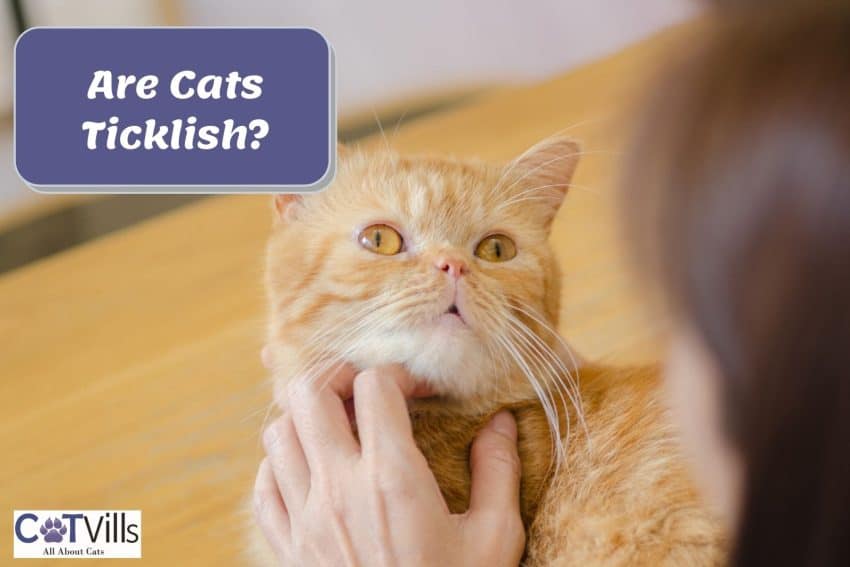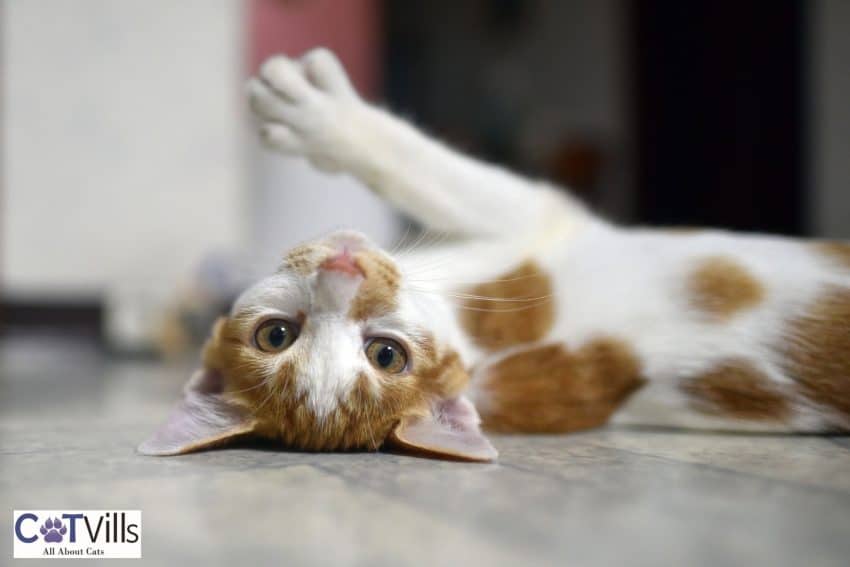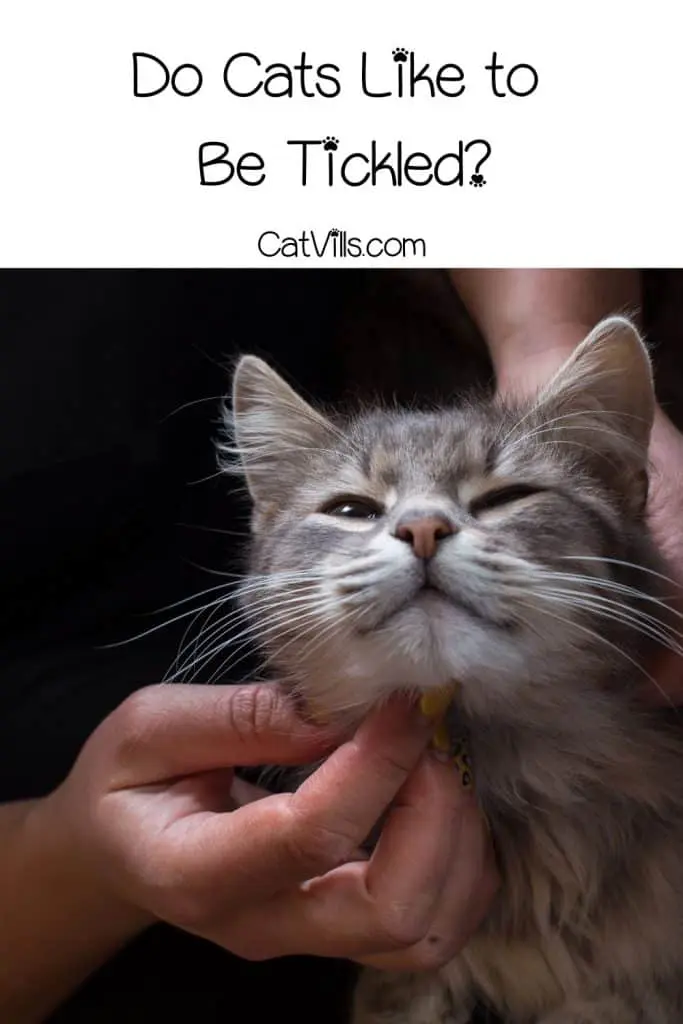Last Updated: 4 months ago
As much as pet owners enjoy scratching their cats, one can’t help but wonder: are cats ticklish?
This is a common question cat owner always seem to wonder about.
The answer to this question seems more obvious for dogs since dogs easily react when hit on the right tickle spot.
Cats though seem to be quite different. If they do have tickle spots, do they like being tickled?
And now, the answer to the million-dollar question that you, yourself, may be asking. Yes! Cats are indeed ticklish.
Where Are Cats Ticklish?

The sensation of tickling in a cat, otherwise known as knismesis, is felt by a cat along his chin, cheeks, belly, and paws.
There may be other areas too where a cat may feel ticklish, such as the back of his legs or the base of his tail.
Be aware though there are areas that may seem to be a tickle spot, but really aren’t.
Areas, such as the back of the tail base, may elicit reactions from a cat that may seem like he is getting tickled when, in fact, as part of a simple neural mechanism it may just be a simple involuntary muscle spasm or nerve reflex.
It may also be a reaction to a skin infection, similar to how a cat would react if there were an insect or flea in his fur.
Do cats like being tickled?

Just like humans, some cats do enjoy a bit of tickling and some don’t. Cats really exhibit different kinds of behavior.
Those behavioral differences may be because of the cat’s individual personality or because of his breed.
It may also be that a cat may initially enjoy the sensation of tickling and after a few minutes, end up being overstimulated. Since they can be easily overstimulated, it is best to keep tickling sessions short.
The important thing though is that when you engage in some tickle time with your furry friend, make sure that you become aware of his body language in order to know when he’s had enough.
There are behavioral signs after all which may indicate just how much he is enjoying this particular activity. Cats can usually become aggressive once they no longer enjoy the sensation.
Common warning signs to let you know that your cat is slowly getting irritated by your form of tickling may be hissing or even growling and deep long meows.
If his body starts to tense up or if he starts swiping his paw at you, chances are he is starting to get peeved with what you are doing to him.
On the other hand, if he starts to purr, nudge at your hand or even start to knead, he most likely is enjoying the moment.
These actions are, after all, common bonding behavior that cats show when they do enjoy the company that they presently keep.
Where TO and NOT TO touch your cat
Unless you actually like wearing Band-Aids, there are definitely some “off-limits” spots to touch your cats.
Let’s check them out, along with the places that they actually enjoy being touched.
Where do cats enjoy being touched?

The sweet spot for most cats is the area under the chin.
This is probably because of the fact that cats, tend to show affection by nudging each other along the chin area as well.
In fact, this is even done by a mother cat to her kittens. There should be an underscore on the word “most” though since all cats are different.
While most cats will enjoy being touched and stroked below their chin, there may be some that don’t.
Bear in mind too that too much stroking may cause overstimulation so it is best to limit the number of strokes to a minimum.
Another area that may be a favorite spot for cats is the area beneath their paws. There is a slight caveat to this though since this is more noticeable among long-haired cats rather than short-haired ones.
This is because of the extra tufts of fur on the paws of long-haired cats which may add to the ticklish sensation that they feel along the area.
Where don’t cats like to be touched?

When a cat shows his belly, humans oftentimes think that it’s because they need a belly rub. Other pets, like dogs, maybe fans of belly rubs. The same can’t be said about cats though.
The belly area in cats is where you can usually find the thinnest skin in a cat. Having the thinnest skin means that it can be easily irritated or overstimulated.
That said, cats will have different reactions to a belly rub. Some will like it. Some won’t. So it really is a risk that you will be taking if you try to tickle your cat on the belly.
It cannot be emphasized enough that you should always take note of your cat’s reactions in order to know when enough is enough.
You wouldn’t want to end up with scratches and a cat in a bad mood. Think Garfield and Jon Arbuckle. You wouldn’t want to end up with pie on your face.
How do you tickle a cat?
As a caring pet parent, you really would want some physical interaction with your feline friend. Tickling sessions may be god bonding activities, but how do you exactly tickle a cat then?
Before you start trying to tickle your spot, always keep in mind that you should be aware of his reactions and changes in behavior since this is the only way for you to really know what your cat is feeling.
To find your pet’s ticklish spots, you can try stroking your cat using light touches starting from the head working your way down towards its entire body.
Avoid doing sudden movements too since this can stress out and startle your cat. Let your cat lead you to where his favorite spot is.
Be mindful of how he communicates with you. Again, it’s all about your cat’s body language. Nudging, purring and gentle movements mean that he is enjoying the activity.
Any unusual behavior, such as hissing, or him trying to swipe his paw at you, will mean that he is getting overstimulated or irritated. It will mean discomfort on his part and that is a sign that you should stop.
FAQs
DO CATS LAUGH WHEN YOU TICKLE?
No. Laughter in humans, when experiencing a ticklish sensation, is a characteristic seen only in humans and primates. This is known as “gargalesis”.
Cats experience what is called “knismeses”, which is a totally different sensation. This does not elicit a sensation that will make them want to “laugh”.
While tickling may initially be a pleasant experience for them, it can easily change to overstimulation which can be a source of irritation to your pet cat.
HOW CAN YOU TELL IF A CAT IS TICKLISH?
You can tell if a cat is ticklish by observing its body language. Cats will usually purr or nudge themselves against their pet human if they enjoy the sensation of being tickled.
Aggressive behavior may also mean that he getting tickled or stimulated but in a different way. While humans, or even dogs, may experience tickling as something enjoyable, cats react quite differently.
For cats, overstimulation does happen faster than in humans. Observing your cat’s reactions is best in order to know how he fares with the experience.
Conclusion
As a pet parent, it is quite normal for you to want some physical interaction or bonding moment with your pet cat.
Tickling is one way by which you can show affection towards your feline friend.
Bear in mind though that tickling, for your cat, is a totally different experience which he may or may not enjoy.
Always be mindful of what your cat is telling you in order for both of you to enjoy this moment of affection between the both of you.
Do you like to tickle your cat? What’s his/her reaction? Let us know in the comments below!
Resources:


Barry Stingmore is a British content creator living in Fuerteventura, Spain. An animal lover at heart, he shares his home with a dog and four rescue cats. Barry works with the island’s animal charities to help manage and care for feral and abandoned animals. Alongside fieldwork, he works to support the charities with fundraising and raising awareness.
